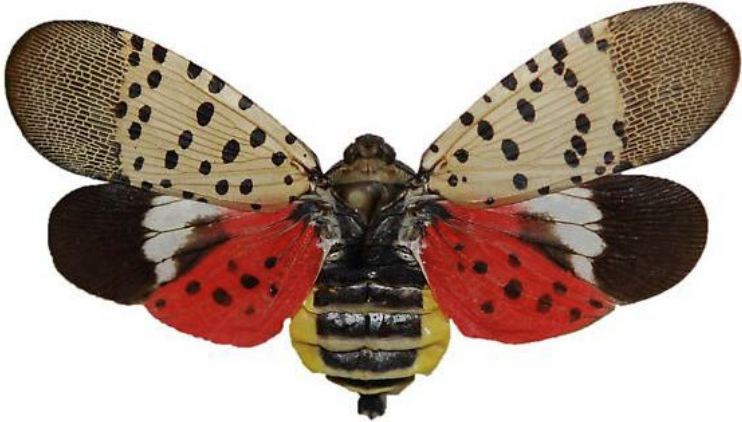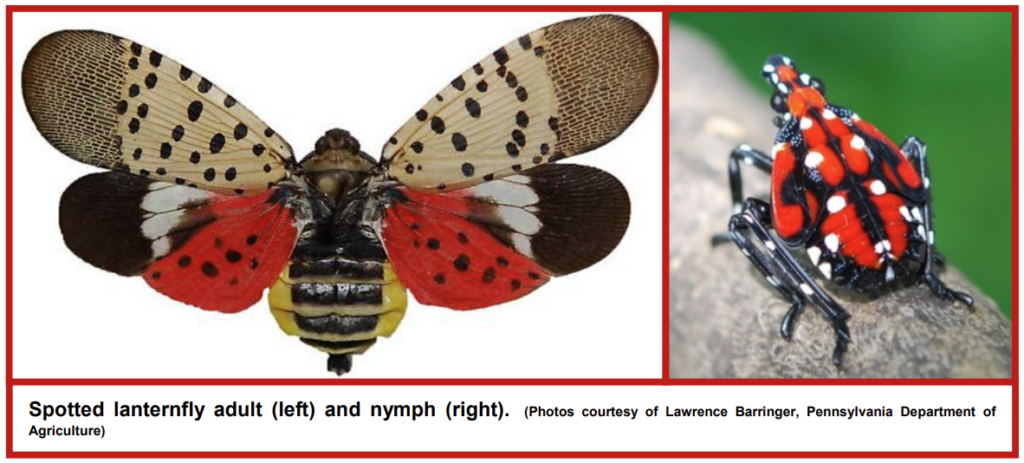Authors: P.J. Liesch and Christelle Guédot (UW-Madison Entomology)
In recent news, spotted lanternfly (Lycorma delicatula), an invasive insect species native to Asia, has been sighted in Illinois. Spotted Lanternfly is not a threat to humans but poses a significant threat to various plant species. Learn more about Spotted Lanternfly with the resources below:

What is Spotted Lanternfly?
Spotted lanternfly is an invasive planthopper native to China, India, and Vietnam. It was first detected in the U.S. in Pennsylvania in 2014, most likely arriving up to two years earlier as egg masses on materials imported from China.
How do I identify Spotted Lanternfly?

Adult spotted lanternflies are ~1″ long and ½” wide when resting. The insects’ forewings are light brown/grey with black spots at the base and have a grey net-like pattern at the tips. The hindwings are red with black spots at the base, have white bands near the center, and have a black net-like pattern at the tips. The heads and legs of adults are black, while their abdomens are yellow with broad black bands. When resting, adults fold their wings over their bodies and appear light brown to grey with black spots. The adult female has a red spot at the tip of the abdomen. Egg masses are 1 – 1½” long and ½ – ¾” wide, greyish-brown, covered with a grey, waxy coating, and contain 30 – 50 eggs. First stage immature nymphs are wingless and black with white spots. As nymphs mature, they eventually develop red patches, but retain their white spots.
How does Spotted Lanternfly spread?
Based on catch and release studies, spotted lanternfly are hoppers and generally do not travel far on their own. Adults are not strong fliers. Adults travel ~100 feet in their lifetime, therefore, accidental human transport of egg masses (nursery shipments, egg masses on vehicles, etc.) poses the greatest risk for introduction of Spotted Lanternfly into Wisconsin.
What do I do if I find a Spotted Lanternfly in Wisconsin?
If you suspect that you have found spotted lanternfly, please contact the University of Wisconsin-Madison/Extension Insect Diagnostic Lab at (608) 262-6510 | pliesch@wisc.edu or submit your sighting at DATCP (scroll to the bottom of the page and select “report it immediately”).
What plants are threatened by Spotted Lanternfly?
Spotted lanternfly has a wide host range and nymphs appear to feed on leaves and branches of virtually any plant they encounter, often gathering in large numbers. As spotted lanternfly juveniles mature, they shift from more tender plants (e.g., herbaceous plants) to woody plants (e.g, trees). In the fall, spotted lanternfly adults gather in large numbers on Tree of Heaven (Ailanthus altissima), willow, maple, birch, poplar, tulip poplar, ash, oak, grape, apple and stone fruit trees (e.g., cherries and plums).
Tree of Heaven is a preferred fall feeding host for spotted lanternfly adults, as well as a preferred mating and egg laying site. This plant is an invasive species native to China that grows in disturbed sites and along roadsides.
How do I identify Tree of Heaven?
Will Spotted Lanternfly kill my trees?
Young woody perennials, especially grapes, hops, and fruit trees, are most vulnerable but mature trees likely can withstand the insect damage. The insects suck on plant sap which reduces the plant’s energy reserves. Spotted lanternfly also leaves behind a sticky sap that can lead to bacterial and fungal growth on plant tissues. Research from the eastern US suggests that spotted lanternflies are more of a nuisance than a threat to the health of residential yard trees.
Where can I learn more?
Visit our Factsheets for more detailed information:
Or watch our Webinar on spotted lanternfly:
The Extension Agriculture Institute connects Wisconsin’s agriculture and horticulture communities to university research. The five program areas; Agriculture Water Quality, Crops and Soils, Dairy and Livestock, Farm Management, and Horticulture provide resources that promote economic and environmental sustainability in Wisconsin. Learn more about these program areas at: extension.wisc.edu/agriculture
Acknowledgement:
Lauren Mortensen for general support and web editing.




